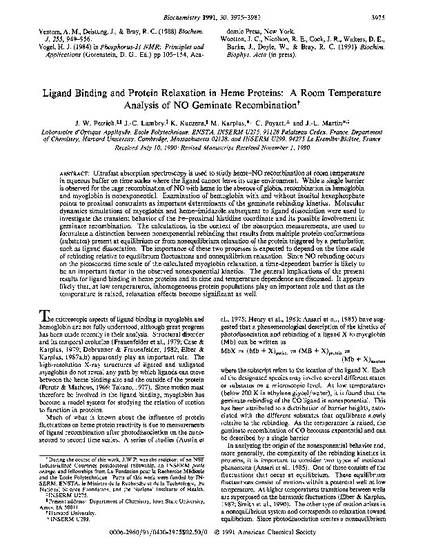
Ultrafast absorption spectroscopy is used to study heme-NO recombination at room temperature in aqueous buffer on time scales where the ligand cannot leave its cage environment. While a single barrier is observed for the cage recombination of NO with heme in the absence of globin, recombination in hemoglobin and myoglobin is nonexponential. Examination of hemoglobin with and without inositol hexaphosphate points to proximal constraints as important determinants of the geminate rebinding kinetics. Molecular dynamics simulations of myoglobin and heme-imidazole subsequent to ligand dissociation were used to investigate the transient behavior of the Fe-proximal histidine coordinate and its possible involvement in geminate recombination. The calculations, in the context of the absorption measurements, are used to formulate a distinction between nonexponential rebinding that results from multiple protein conformations (substates) present at equilibrium or from nonequilibrium relaxation of the protein triggered by a perturbation such as ligand dissociation. The importance of these two processes is expected to depend on the time scale of rebinding relative to equilibrium fluctuations and nonequilibrium relaxation. Since NO rebinding occurs on the picosecond time scale of the calculated myoglobin relaxation, a time-dependent barrier is likely to be an important factor in the observed nonexponential kinetics. The general implications of the present results for ligand binding in heme proteins and its time and temperature dependence are discussed. It appears likely that, at low temperatures, inhomogeneous protein populations play an important role and that as the temperature is raised, relaxation effects become significant as well.
Available at: http://works.bepress.com/jacob_petrich/49/

Reprinted (adapted) with permission from Biochemistry 30 (1991): 3975, doi: 10.1021/bi00230a025. Copyright 1991 American Chemical Society.